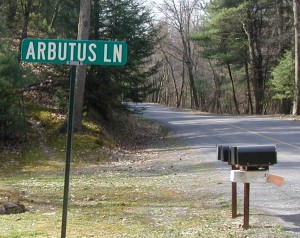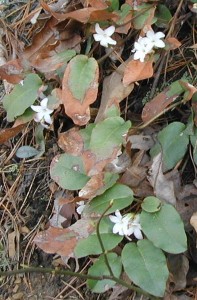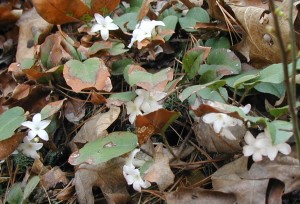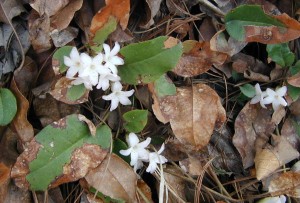I remember reading about the Trailing Arbutus and that it could be found at the Box Huckleberry Natural Area of the Tuscarora State Forest in New Bloomfield, Pennsylvania.
When I took a day-trip over there on 3 April 2010, it took a while to find them. But I finally did!

Near the entrance of the Box Huckleberry Natural Area is a side road called Arbutus Lane. Very close to the spot where Arbutus Lane meets Huckleberry Road is a patch of trailing arbutus. The patch of arbutus we saw was about 2 ft by 3 ft in size under the trees at the border of the State Forest.
Trailing arbutus, Epigaea repens, sometimes called the “Mayflower”, is a member of the heath family, just as the huckleberry is. They do occur in the same habitat, shady places under trees. These perennials both have oval-shaped evergreen leaves, but arbutus leaves are 2-3 times bigger than huckleberry leaves.

Arbutus leaves that last over winter may turn brown at the ends.
Flowers are partially tucked under the old leaves and may not be visible to the casual passerby. Here, the shiny trailing Arbutus blossoms were quite noticeable in the sunlight among the old brown leaves, even though they grew so near the ground.

In the photo above there are four flower clusters, three of which are mostly hidden under the arbutus leaves.
A cluster of two or more, five-petaled, white blossoms appear like partridgeberry blooms with their elongated bell shape. The five petals flare out at the ends of the trumpet-like bell. They also smelled wonderfully sweet.


Now that I’ve seen trailing arbutus I’ll be more likely to spot it in other places, especially when the plant is not blooming.
Peterson’s Medicinal Plants Guide states that Native Americans used a leaf tea to treat kidney and stomach disorders. Arbutus was also used as a folk remedy for urinary problems. Arbutus itself might not be toxic, but a chemical formed in our bodies – as a result of drinking arbutus tea – is toxic. We can’t recommend drinking this tea, so we’ll just admire the trailing arbutus on the trail.
I seem to remember my dad talking about trailing arbutus. If memory serves, he talked about the root being edible. Is that so? While berrying last week I came across a “field” of arbutus. It brought back memories of walking through wooded areas and fields with my parents. My Father would pick out edible plants, saying ” There is no reason why anyone should starve living in this area of New England”! Unfortunately, our forests and streams have been nearly wiped out as the demand for Homes and industry has grown.
Hi Jacquelyn,
It’s berry time around here too. The extreme heat and lack of rain as of late has the blackberries all but dried up.
How nice to find a ‘field’ of trailing arbutus! It is protected in many areas because – as you mentioned – its habitat has been decimated.
Trailing arbutus flowers are edible. The corolla or flower tube can be added to salads or eaten on the trail as a sweet and sour nibble. I could find nothing stating that the root is edible. At one time American Natives used a leaf tea for urinary complaints, but that is no longer recommended as we know that a leaf compound (arbutin) is metabolized into a toxic one (hydroquinone) inside the body.
Eating a flower tube or two won’t hurt you, but make sure this plant is not protected in your area first.
Thanks for sharing!
there’s a fairly healthy population of trailing arbutus in and around Cornwall, NY (in the Hudson Highlands). A person would have to know the area very well and be very patient to hunt them down, but they’re there, and doing well. I’d be hesitant to say anything more since it’s my understanding that, about 100 yrs ago, people hunting and picking these wonderful plants was the cause for their being so rare now. some people just want to capture that orange blossom sweetness and take it with them. save yourself (and the environment) the trouble. i understand that they don’t transplant or propagate well and usually end up dead. it’s so discouraging that there used to be many wonderful things out in the woods around here that i will never get to see because they’ve been removed by overzealous “fans.” i will never see a blue gentian in the wild for this very reason, i’ve only found one specimen of Walking fern (probably for the same reason.). also, i did find what looks like a new and different patch of arbutus, further out in the woods in my area, but these plants had a bit of serrating on some of the leaves….. now i’m not sure what it is (?) in every other respect, they sure look like arbutus plants to me. i should return with a camera. can arbutuses sometimes have a bit of serration? in other news, we have a hearty population of pink lady slipper orchids in a patch of woods not far from me. now that is a huge pleasure.
Hey Renee,
I know exactly what you mean. I’m still looking for a blue gentian! The lack of success in transplanting arbutus may have to do with not replicating the conditions needed, like being in a forest. Planting one under a tree in your yard just isn’t the same thing.
As far as the serrated leaves go, please get a photo when you can. Was the plant blooming at the time? My field books don’t mention any serration for the oval, leathery leaves of arbutus. If the plant looks like arbutus in all other respects, I’d call it an arbutus with a little individual variation. If other characters don’t seem quite right for it, try to get a few photos so we can find out what it is.
Thanks for sharing and Good luck!
6-28-2016
I’m curious about about this site–is it still active?
When I was in my teens my uncle became very ill & his physicians at The University of Virginia told he & his family that he had a condition called BRIGHTS DISEASE which had progressed to the stage of certain death. He was instructed to go home, get his affairs in order, & rest.
My family owned a farm of many, many acres with acres of a wonderful woodland, with several springs of fresh water, & wildlife that was safe because all the average was “Posted—NO HUNTING!” We grandchildren roamed this woodland, considering it our very own utopia.
Back to my uncle: When he came home, dejected, ill, & with no hope of survival, he fell into a deep depression. Our family knew that he would die unless something drastic was done. My mother & my grandmother went into the woods & carefully selected sacks of Trailing Arbutus which they boiled down into a very strong tea.
My uncle would hardly agree to anything especially something no one had ever heard of. His family did not use wild herbs, etc. With prodding from his daughter he began sipping it, continuing this for weeks. His kidneys began producing a bit of urine & my grandmother noticed that his face was not as swollen but she said nothing to anyone except my mother. This tea making & sipping continued through the summer ’till my uncle began sitting up by himself & was able to walk to the dining room.
The physicians had given him an appointment card for later in the fall. When they called him into the office they asked why he was there, he reiterated the last visit & the doctor decided to examine him & run some tests. After all was complete the doctor had the family wait ’till he could get all my uncles medical records. After conferring with a group of physicians, my uncles doctor told the family that there was no indication that he had ever had Brights Disease. He then asked what he had been doing & the family told him; he did not believe them & said my uncle would be dead if he had drunk a tiny bit Trailing Arbutus Tea. My uncle & his family left UVA & he saw a local physician ’till he died of Natural Causes!
Yes, Barbara! This site is still active. Thank you so much for your interesting story about your Uncle’s miracle cure!
I haven’t known anyone unfortunate to have experienced Bright’s Disease, but it apparently involves kidney inflammation, irritation and stones as a result of excess protein/albumin buildup. If caught early it’s treatable through dietary changes and gaining control of diabetes and high blood pressure which are two potential causes of the disease.
Another name for Trailing Arbutus is Gravel Plant which denotes its past use in treating kidney stones, a.k.a. gravel.
Modern medicine might not choose to use Trailing Arbutus to clean up the kidneys, but evidently some Native American tribes relied on it to treat bladder and urinary troubles. Treatments are specified in the King’s American Dispensatory of 1898 for “all diseases of the urinary organs” where irritation exists. The chemicals in that strong trailing arbutus tea must have acted liked an antiseptic and anti-inflammatory in your uncle’s case.
If it were my last chance therapy, I would have chosen to drink the tea. I mean, why not? When you can’t pee, you’re doomed!
By the way I loved your description of your family’s wooded acres with fresh springs and wildlife as the grandchildren’s utopia! My kind of place. 🙂 Thanks again for sharing your story.